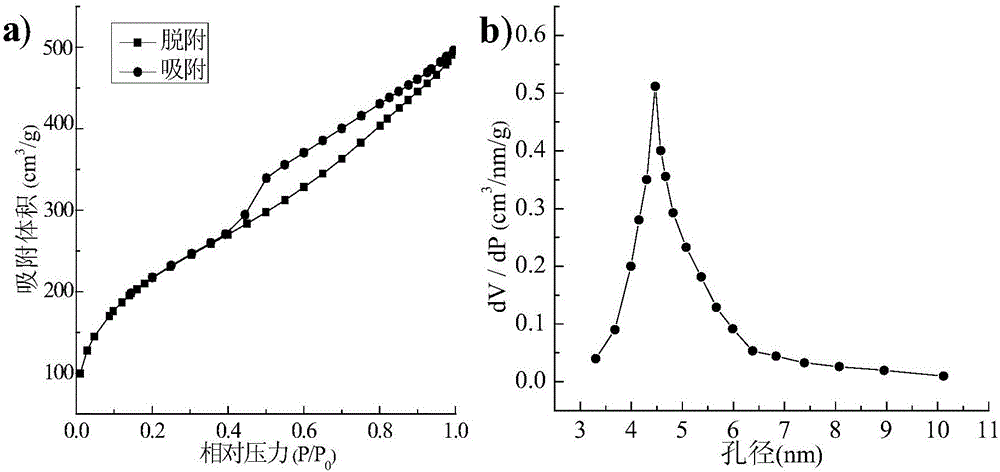Preparation of mesoporous molecular imprinting fluorescent probe and detection of tetracycline antibiotics by mesoporous molecular imprinting fluorescent probe
A technology of molecular imprinting and fluorescent probes, applied in fluorescence/phosphorescence, analytical materials, luminescent materials, etc., can solve the problems of cumbersome sample pretreatment process, poor selectivity of target molecules, and long analysis time, so as to reduce analysis cost and select The effect of strong stability and simplified analysis steps
- Summary
- Abstract
- Description
- Claims
- Application Information
AI Technical Summary
Problems solved by technology
Method used
Image
Examples
Embodiment 1
[0018] This embodiment is the preparation of mesoporous molecularly imprinted fluorescent probes, which are specifically completed according to the following steps:
[0019] 1. Preparation of molecularly imprinted polymer: Mix 1.5g of aureomycin solid with 30mL of tetrahydrofuran and 6mL of isocyanatopropyltriethoxysilane, stir and react at 100°C for 24h (nitrogen protection), and the stirring speed is 350r / min, and then remove THF by a rotary evaporator to obtain a prepolymerization solution; then add 0.05mL prepolymerization solution, 0.45g hexadecyltrimethylammonium bromide, 2.25mL ethyl orthosilicate, 67.5mL volume fraction Add 56% ethanol aqueous solution into the Erlenmeyer flask, finally add 0.875mL2mol / L NaOH solution, stir at room temperature for 2h, then put it into a high-temperature reactor and react at 120°C for 48h, after the reaction, carry out suction filtration to obtain a solid product, a solid product Centrifuge and wash with distilled water for 3 to 5 time...
Embodiment 2
[0023] This embodiment is an application of a mesoporous molecularly imprinted fluorescent probe in the detection of chlortetracycline, which is completed according to the following steps: respectively mix 0.2 g of mesoporous molecularly imprinted fluorescent probe with a concentration of 50-1000 ng / mL Mix the chlortetracycline sample solution and adjust the pH of the mixture to 8, disperse it evenly by ultrasonication for 2 minutes, and then use the fluorescence spectrophotometer to perform fluorescence analysis in turn after standing at room temperature for 10 minutes, that is, the detection of chlortetracycline by the mesoporous molecular imprinted fluorescent probe is completed. The application in the element; its fluorescence detection condition is set as follows:
[0024]
[0025] The results show that the standard addition recovery rate of aureomycin obtained by the method established by the present invention is 92.1%~97.5%, the relative standard deviation (RSD) is 2....
PUM
 Login to View More
Login to View More Abstract
Description
Claims
Application Information
 Login to View More
Login to View More - R&D
- Intellectual Property
- Life Sciences
- Materials
- Tech Scout
- Unparalleled Data Quality
- Higher Quality Content
- 60% Fewer Hallucinations
Browse by: Latest US Patents, China's latest patents, Technical Efficacy Thesaurus, Application Domain, Technology Topic, Popular Technical Reports.
© 2025 PatSnap. All rights reserved.Legal|Privacy policy|Modern Slavery Act Transparency Statement|Sitemap|About US| Contact US: help@patsnap.com



